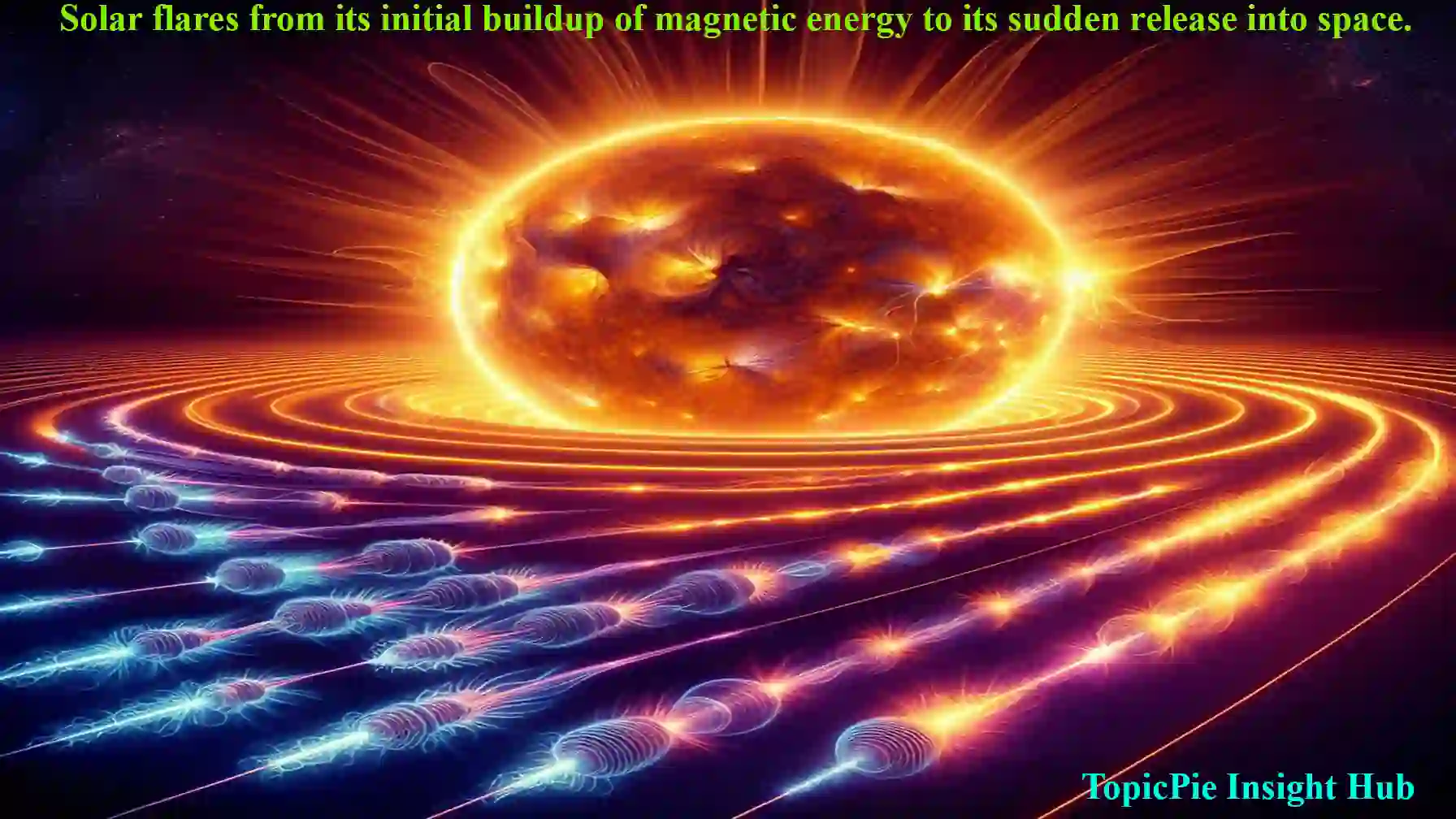Have you ever gazed skyward and marveled at the power of the sun? Our nearest star isn’t just a constant source of light and warmth, it’s also a dynamic entity capable of unleashing tremendous bursts of energy known as solar flares. These solar flares are more than a mesmerizing celestial sight; they hold significant influence over our planet Earth.
Solar flares are intense eruptions of radiation and energy that originate from the sun’s atmosphere. They occur when magnetic energy stored within the sun abruptly releases, creating a powerful burst of electromagnetic radiation across the spectrum, from radio waves to X-rays and even gamma rays. The energy unleashed during a solar flare can be mind-boggling – equivalent to millions of hydrogen bombs detonating simultaneously!
Earth hit by radiation from rare ‘double’ X-class solar flare:
Recently, Earth experienced a rare phenomenon when it was hit by radiation from a ‘double’ X-class solar flare. These flares are classified as the most intense and powerful outbursts of energy from the sun. The impact of such solar flares on our planet can be significant, affecting various systems like satellites, power grids, and communication networks.
The radiation released during these events can disrupt radio communications and navigation systems. In extreme cases, they can even pose risks to astronauts in space. Scientists closely monitor these occurrences to better understand their effects on Earth’s magnetic field and atmosphere.
Despite being awe-inspiring celestial events, X-class solar flares remind us of the dynamic relationship between the sun and our planet. As we continue to study them, we gain valuable insights into how they influence Earth’s environment and technological infrastructure.
Also Read: Understanding Main Character Syndrome Fully
Solar Flares Overview:
The sun, our life-giving star, is not always as serene as it appears. Solar flares, intense bursts of radiation and energy released from the sun’s surface, can have significant impacts on Earth. These flares are classified based on their strength – ranging from A (weakest) to X (strongest). When powerful X-class solar flare occur, they can disrupt satellite communications, navigation systems, and even power grids on Earth.
Solar flares are often accompanied by coronal mass ejections (CMEs), massive eruptions of solar wind and magnetic fields. These CMEs can trigger geomagnetic storms when they interact with Earth’s magnetic field. While most solar flare pose no danger to Earth, thanks to our protective atmosphere and magnetic field, strong flares and CMEs can disrupt satellite communications, navigation systems, and even power grids.
Studying solar flares provides valuable insights into the behavior of stars like our sun and helps us better understand space weather dynamics. By monitoring these phenomena closely, scientists strive to improve forecasting capabilities and mitigate potential risks associated with extreme solar activity.
Understanding Solar Flares:

Understanding solar flares is crucial in grasping their impact on Earth. These intense bursts of radiation from the sun are sudden and powerful releases of energy, often accompanied by a coronal mass ejection. A solar flare erupts when stored magnetic energy in the solar atmosphere is abruptly discharged. The process involves interactions between highly energized particles, resulting in electromagnetic radiation across different wavelengths.
Scientists classify solar flare based on their X-ray brightness, ranging from A, B, C, M, to X-class flares – with X being the most intense. The energy released during a large flare can be equivalent to millions of hydrogen bombs exploding simultaneously! Studying these phenomena helps us understand space weather and its potential effects on technology such as satellites and power grids.
Solar flares can also generate geomagnetic storms that affect Earth’s magnetosphere. By monitoring these events closely, scientists can provide early warnings to mitigate any possible impacts on our planet’s infrastructure and technology systems.
Effects of Solar Flares:
Solar flares, powerful bursts of radiation from the sun, can have various effects on Earth. One of the most notable impacts is on our technology and infrastructure. When a strong solar flare hits our planet, it can disrupt satellite communications, GPS systems, and even power grids. This disruption can lead to blackouts in certain regions and affect navigation systems.
Moreover, solar flare can also pose risks to astronauts in space by exposing them to increased levels of radiation. These bursts of energy can interfere with spacecraft electronics and potentially endanger those aboard. Additionally, during intense solar activity, airlines may need to reroute flights near polar regions due to heightened radiation levels.
Furthermore, solar flares are known to cause stunning auroras in the skies near the poles. The charged particles released during these events interact with Earth’s atmosphere, creating beautiful displays of light known as the Northern and Southern Lights.
Observations and Predictions
Observing solar flares is a crucial aspect of space weather monitoring. Scientists use various instruments like satellites and ground-based observatories to track the intensity and frequency of solar flares. By analyzing these observations, researchers can predict the potential impact on Earth’s magnetic field and communication systems.
Predictions about solar flare are based on complex models that take into account factors like sunspot activity, magnetic fields, and past flare history. However, predicting the exact timing and intensity of solar flares remains a challenge. These predictions, while not perfect, help authorities prepare for possible disruptions caused by intense solar activity, such as geomagnetic storms or radio blackouts.
By closely monitoring solar flare activity, scientists can provide early warnings to operators of vulnerable technologies like power grids and satellite communications systems. This proactive approach allows for better preparation and mitigation strategies in the face of powerful solar events.
Historical Perspective:
Solar flares have fascinated scientists and astronomers for centuries, with observations of related solar activity likely dating back to the 1850s. As technology advanced, we gained the ability to directly observe these intense bursts of energy from the Sun with specialized equipment.
In 1859, one of the most powerful solar storms in history occurred – known as the Carrington Event. This event caused widespread disruption to telegraph systems around the world due to its strong geomagnetic effects on Earth’s magnetic field. Subsequent research has shown that if a similar event were to occur today, it could have catastrophic consequences on our modern technological infrastructure.
The historical perspective of solar flares serves as a reminder of their immense power and potential impact on our planet. By studying past events, scientists can better prepare for future occurrences and mitigate any possible risks associated with these awe-inspiring cosmic phenomena.
Also Read: The Rise of the Online Prescription: Convenience and Accessibility Reshape Healthcare
Importance of Solar Flares on Earth:
The importance of solar flares on Earth cannot be overstated. These powerful bursts of energy from the Sun have a significant impact on our planet’s magnetic field and atmosphere. Solar flares can cause geomagnetic storms, which in turn affect communication systems, power grids, and even satellite operations.
Moreover, understanding the behavior of solar flare is crucial for space weather forecasting. By monitoring and studying these phenomena, scientists can better predict when a solar flare might occur and prepare for potential disruptions here on Earth. This knowledge is essential for protecting vital infrastructure and ensuring the safety of astronauts aboard spacecraft.
In addition to their practical implications, solar flares also contribute to scientific research by shedding light on the fundamental processes at work in our Sun. Studying these intense explosions helps us unravel the mysteries of stellar physics and gain insights into how stars evolve over time.
Examples of Large Solar Flares:
In the past, there have been notable examples of large solar flares that have caught the attention of scientists and sky watchers alike. One such event occurred in 1859 when a massive solar flare caused disruptions to telegraph systems around the world. Known as the Carrington Event, it remains one of the most powerful solar storms on record.
Another significant example is the Bastille Day event in 2000, where a powerful X5-class solar flare erupted from the sun. This event led to stunning auroras visible even at lower latitudes and caused some temporary disruptions to satellite communications and power grids. However, the impact wasn’t as widespread or long-lasting as the Carrington Event.
More recently, in September 2017, an X9.3-class solar flare was observed, making it one of the strongest flares detected in over a decade. This intense burst of energy resulted in radio blackouts and heightened geomagnetic activity.
These examples serve as reminders of the potential impact that large solar flares can have on our technology-dependent society.
Solar Flares and Geomagnetic Storms:
Solar flares, those intense bursts of radiation from the sun, can have a significant impact on our planet. When these solar eruptions occur, they can also trigger geomagnetic storms here on Earth. Geomagnetic storms are disturbances in the Earth’s magnetic field caused by changes in solar wind conditions.
During a geomagnetic storm, charged particles from the sun interact with the Earth’s magnetic field and atmosphere. This interaction can lead to stunning auroras at high latitudes but also disrupt communication systems and power grids.
The severity of a geomagnetic storm depends on factors like the strength of the solar flare and its alignment with Earth. In extreme cases, these storms have been known to interfere with satellites and even cause blackouts in certain regions.
Understanding the relationship between solar flares and geomagnetic storms is crucial for predicting their potential impact on our technological infrastructure.
Solar Flares and Radio Blackouts:

Solar flares have the potential to cause disruptions in our daily lives beyond just stunning light displays in the sky. When intense solar flare occurs, they release high-energy radiation that can particularly impact communication systems relying on High-Frequency (HF) radio waves, a range often used for long-distance communication between airplanes, ships at sea, and even emergency responders on the ground.
During a severe solar flare event, these radio signals may experience interference or be completely blocked out. This disruption in communication channels highlights how interconnected our modern world is with space weather phenomena like solar flares. The ability to transmit crucial information during emergencies could be compromised if proper precautions are not taken when these solar events happen.
Understanding the relationship between solar flares and radio blackouts is essential for developing strategies to mitigate their effects, such as utilizing alternative communication channels or having backup communication plans in place, to ensure continued communication reliability during periods of heightened solar activity.
Conclusion:
Solar flares have a profound impact on Earth, affecting our planet in various ways. From disrupting communication systems to creating stunning auroras, these powerful bursts of energy from the sun play a significant role in shaping our space weather environment. Understanding the dynamics of solar flare and their effects is crucial for both scientists and everyday individuals.
As we continue to study solar activity and improve our ability to predict solar flares, we can better prepare for potential disruptions caused by these energetic events. By monitoring the sun’s behavior and its impact on Earth, we can mitigate risks associated with solar flare and safeguard our technological infrastructure.
Solar flares are not just fascinating celestial phenomena but also important drivers of space weather that can influence various aspects of life on Earth. Stay informed about solar activity and its potential impacts to appreciate the intricate relationship between the sun and our planet.
Also Read: The Surprising Ways Your Daily Choices Affect Your Carbon Footprint








